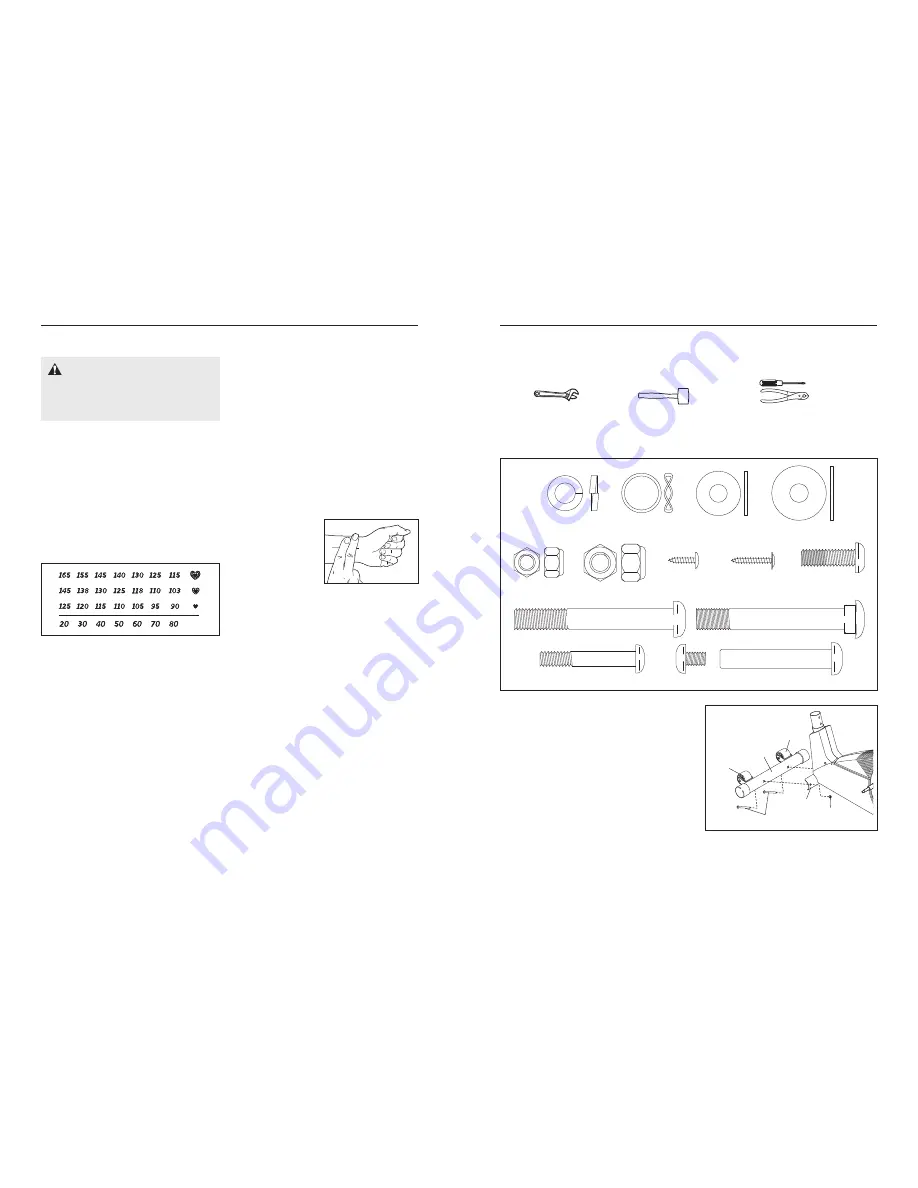
5
12
Use the chart below to identify the small parts used in assembly. The number in parenthesis below each part is
the key number of the part, from the PART LIST on page 14. The number after the key number is the quantity
needed for assembly.
Note: Some parts may have been pre-attached for shipping. If a part is not in the
parts bag, check to see if it has been pre-attached.
M10 x 76mm Button Bolt (67)–2
M8 x 45mm Button
Bolt (50)–4
M4 x 12mm
Screw (42)–4
M8 Nylon
Locknut (38)–6
M10 Nylon
Locknut (33)–6
M10 Split
Washer (59)–2
M10 x 75mm Carriage Bolt (34)–4
M4 x 19mm Flange
Screw (36)–6
Pedal Arm Bolt Set (40)–2
Wave Washer
(73)–2
M8.5
Washer (55)–2
M8.5 Large
Washer (35)–2
M8 x 25mm Patch
Screw (56)–2
CONDITIONING GUIDELINES
The following guidelines will help you to plan your
exercise program. Remember that proper nutrition
and adequate rest are essential for successful results.
EXERCISE INTENSITY
Whether your goal is to burn fat or to strengthen your
cardiovascular system, the key to achieving the
desired results is to exercise with the proper intensity.
The proper intensity level can be found by using your
heart rate as a guide. The chart below shows recom-
mended heart rates for fat burning, maximum fat
burning, and cardiovascular (aerobic) exercise.
To find the proper heart rate for you, first find your age
near the bottom of the chart (ages are rounded off to
the nearest ten years). Next, find the three numbers
above your age. The three numbers are your “training
zone.” The lowest number is the recommended heart
rate for fat burning, the middle number is the recom-
mended heart rate for maximum fat burning, and the
highest number is the recommended heart rate for
aerobic exercise.
Burning Fat
To burn fat effectively, you must exercise at a relative-
ly low intensity level for a sustained period of time.
During the first few minutes of exercise, your body
uses easily accessible
carbohydrate
calories for ener-
gy. Only after the first few minutes of exercise does
your body begin to use stored
fat
calories for energy.
If your goal is to burn fat, adjust the intensity of your
exercise until your heart rate is near one of the lower
two numbers in your training zone as you exercise.
Aerobic Exercise
If your goal is to strengthen your cardiovascular sys-
tem, your exercise must be “aerobic.” Aerobic exer-
cise is activity that requires large amounts of oxygen
for prolonged periods of time. This increases the
demand on the heart to pump blood to the muscles,
and on the lungs to oxygenate the blood. For aerobic
exercise, adjust the intensity of your exercise until
your heart rate is near the highest number in your
training zone.
HOW TO MEASURE YOUR HEART RATE
To measure your
heart rate, first exer-
cise for at least four
minutes. Then, stop
exercising and place
two fingers on your
wrist as shown. Take
a six-second heart-
beat count, and multi-
ply the result by 10 to find your heart rate. For exam-
ple, if your six-second heartbeat count is 14, your
heart rate is 140 beats per minute. (A six-second
count is used because your heart rate will drop rapidly
when you stop exercising.)
WORKOUT GUIDELINES
Each workout should include the following three parts:
A warm-up
, consisting of 5 to 10 minutes of stretching
and light exercise. A proper warm-up increases your
body temperature, heart rate, and circulation in prepa-
ration for exercise.
Training zone exercise
, consisting of 20 to 30 min-
utes of exercising with your heart rate in your training
zone. (During the first few weeks of your exercise pro-
gram, do not keep your heart rate in your training
zone for longer than 20 minutes.)
A cool-down
, with 5 to 10 minutes of stretching. This
will increase the flexibility of your muscles and will
help to prevent post-exercise problems.
WARNING:
Before beginning
this or any exercise program, consult your
physician. This is especially important for
persons over the age of 35 or persons with
pre-existing health problems.
ASSEMBLY
Assembly requires two persons.
Place all parts of the elliptical trainer in a cleared area and remove the pack-
ing materials. Do not dispose of the packing materials until assembly is completed.
In addition to the included hex keys, assembly requires a phillips screwdriver , two adjustable
spanners , a rubber mallet , and a pair of pliers .
1. Identify the Front Stabiliser (10). Whilst another per-
son lifts the front of the Frame (1), attach the Front
Stabiliser to the Frame with two M10 x 75mm
Carriage Bolts (34) and two M10 Nylon Locknuts
(33).
Make sure that the Front Stabiliser is turned
so the Wheels (22) are not touching the floor.
1
1
10
22
22
33
34

























